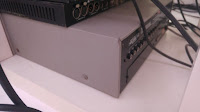Мэтью Полк из компании «Polk Audio» неоднократно заявлял, что проектировщики акустических систем должны прекратить постоянно менять модели динамиков на новые, для извлечения выгоды от реализации обновленных моделей. Видимо, Bose Corporation из штата Массачусетс, придерживается того же самого!
Конструкция образца 1975 года претерпела минимальные изменения. Полочная акустическая система Bose 301 первой серии для воспроизведения баса использует низкочастотный динамик с бумажным конусом 200 мм и один высокочастотный динамик расположенный сбоку с портом для расширения баса и с контролем направленности высокочастотного спектра при помощи вращающейся лопасти, установленной перед ВЧ-динамиком.
Использование запатентованной корпорацией Bose® технологии дизайна громкоговорителей Direct/Reflecting® позволяет слушателям наслаждаться естественным балансом направленного и отраженного звука, что дает иллюзию объемного трехмерного звучания практически в любом месте комнаты.
При прослушивании музыки почти весь звук отражается от стен, потолка и пола. Лишь около 11% звука достигает слушателей непосредственно из динамиков.
Слушатели сами могут сами выбирать место отражения звука, в зависимости от угла поворота громкоговорителя.
В результате, при правильно установленных громкоговорителях Вы слышите звук, очень напоминающий звучание концертного зала, как будто Вы присутствуете на живом концерте.
В настоящее время 2-х полосная акустика Bose-301 это один из самых популярных громкоговорителей всех времен и народов.
Стоит ли удивляться, что удачный дизайн до сих пор пользуется заслуженным спросом, а изделия компании Bose являются самыми продаваемыми динамики в мире.
Bose 301 Series II
В 1983 году была спроектирована и выпущена обновленная версия акустической системы Bose 301, которая получила известность в качестве 301 Series II.
Акустические системы 2-й серии были не менее успешны своих предшественниц, Bose 301 Series I и II выпускались восемь лет, оставаясь в производстве до 1991 года.
В дизайне второй серии Bose 301 Series II появился второй высокочастотный динамик для создания более свободного массивного пространства высокочастотного спектра.
Два 3-х дюймовых высокочастотных громкоговорителя имели крепление под углом в разных направлениях и устанавливались в противоположных сторонах корпуса акустики, и имели разную направленность, один был направлен вперед и один назад.
Акустическая система Bose 301 Series II имела номинальное сопротивление 8 Ом и рассчитана для работы с усилителями, вырабатывающими мощность от 10 до 75 Вт на канал.

Country: United States of America (USA)
Manufacturer / Brand: BOSE Corporation; Framingham (MA),
Year: 1982 ?
Category: Loudspeaker, headphone or earphone
Wave bands - without
Details
Power type and voltage No Power needed
Loudspeaker 3 Loudspeakers
Power out
Model: 301 Series II - BOSE Corporation; Framingham
Material Wooden case
Shape Tablemodel, high profile (upright - NOT Cathedral nor decorative).
Dimensions (WHD) 270 x 430 x 240 mm / 10.6 x 16.9 x 9.4 inch
Notes
- Type: 2 way, 3 driver loudspeaker system
- Power Handling: 75W
- Recommended Amplifier: 10 to 150W
- Impedance: 8Ω
- Bass: 1 x 200mm cone
- Tweeter: 2 x 76mm cone
- Finish: black, white, walnut
- Bose 301 Series II, Direct/Reflecting System. Belastbarkeit lt. Hersteller 75W.
Net weight (2.2 lb = 1 kg) 7.1 kg / 15 lb 10.2 oz (15.639 lb)
New price approx .: 448 DM
![Infrequent Sound [sex.tex] technology](https://blogger.googleusercontent.com/img/b/R29vZ2xl/AVvXsEgYjsR0yBjx1asXd9RcHaPAqGmfjf3vlwTTJNdkEd5mSGJ9rJWByMDPi2EsfWrHP7UxXHcPrZNpbPrcnBAsAdc8IC2laTcEEtBPU0Sn15W8ej00BbKglgMk3POjsvF9FbhoZXwGGlMdLywV/s1328/1+2.jpg)















































